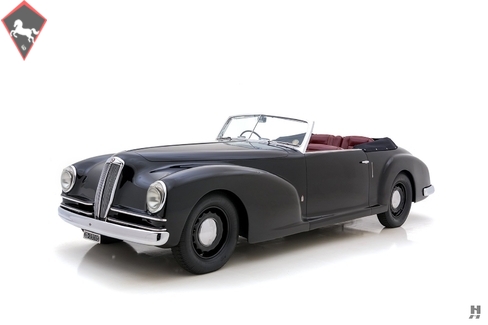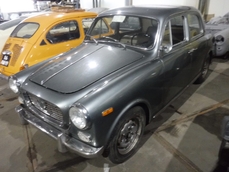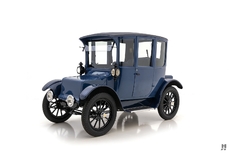Lancia Other 1938
Allgemeine Beschreibung :
When the Astura debuted in 1931, Lancia was already well-established as one of the most respected automobile manufacturers in the world. The brilliant engineer Vincenzo Lancia gave life to such vehicles as the Kappa, Lambda, and Dilambda – all revered for their advanced engineering, superb build quality, and revolutionary design features. Because Lancia was a small company, new models often overlapped with outgoing ones, as was the case with the Astura, which sold alongside the Dilambda for the first few years. Like the Dilambda, the Astura featured a separate chassis rather than the stressed unitary body of the Lambda. While arguably a step back technologically, this allowed Italy’s finest coachbuilders to work their magic on the otherwise brilliant platform. The design was shared with the four-cylinder Artena, though the Astura served the flagship role thanks to the superb, ingenious narrow-angle V8 engine. The Astura formed the basis of some of the most spectacular of all pre-war Lancias, favored by Italy’s cultural and political elite throughout the 30s.
For the Series III, the Astura gained the three-liter version of the V8 engine, hydraulic brakes, and the option of short or long-chassis variants. The final Series IV version, built between 1937 and 1939, featured the same mechanical spec but was only available in a long-wheelbase form. Coachbuilders across Europe made the most of Lancia’s superb flagship, and stunning designs came from the likes of Pourtout, Castagna, Stabilimenti Farina, and the fledgling Pinin Farina – which would go on to create many breathtaking creations based on the Astura.
As one of the last Asturas built, chassis number 413195 is a long-wheelbase fourth-series example, wearing sophisticated and elegant one-off cabriolet coachwork by Pinin Farina. According to the marque historian and collector Hervé Charbonneaux, himself a past owner of this car, S/N 413195 was completed on November 17, 1938, bound for Carrozzeria Pinin Farina. The chassis was said to be a special order by Count Galeazzo Ciano, Benito Mussolini’s son-in-law, and his right-hand man as the chief propagandist in the fascist government. Like many high-ranking Italian officials, Ciano was a Lancia connoisseur and had at least one other Astura in his private stable. But just as 413195 arrived at the coachbuilder’s workshop, Italy’s involvement in World War II interrupted all of Italian industry, meaning Pinin Farina would not complete the job until after the war. Unfortunately for Count Ciano, he would never take delivery of his Lancia. When he suggested Italy may be on the losing side of WWII, Mussolini summarily stripped him of his post for what he saw as the ultimate betrayal of trust. In 1944, Ciano met his fate by firing squad on Mussolini’s orders.
The Astura remained at the Pinin Farina workshop through the end of the war. With auto production in Italy at essentially zero, coachbuilders were desperate for work. They began pushing the boundaries of design to attract what few buyers still had the means for bespoke coachwork. In 1947, Pinin Farina completed the striking body for 413195, debuting it on their stand at the Turin Auto Show the same year. It was apparently purchased by noted art collector and French aristocrat Baron Napoleon Gourgaud, where it lived a gentle life as part of his Paris museum. In 1971, Philippe Charbonneaux and his son Hervé purchased the Lancia from the Gourgaud collection and displayed it at their museum near St. Dizier. The collection still exists as the Musée automobile Reim-Champagne, and a film on their website from 1972 momentarily captures the Astura, appearing to remarkably sound and in original condition at the time – albeit a bit dusty.
It is understood that the next owner was Marco Gastaldi, who acquired it from the Charbonneaux collection in 1977 and owned it through 1992. In 1993, Gastaldi sold it to Carlo Montorfano, who commissioned Italian restorer Mario Galbiati to perform a mechanical overhaul and cosmetic freshening, preserving the car’s original interior. It changed hands again in 2007 and has since been in the care of devoted enthusiasts who have maintained it in superb condition.
The imposing and grand Astura possesses a remarkable presence. Pinin Farina’s brilliance is on full display, making the most of the 137-inch wheelbase with a graceful and sophisticated fully-enveloped design that was years ahead of its time. The lack of excessive trim or finicky grille designs is in stark contrast to many early post-war cars, and the car exudes quiet elegance. It is strikingly finished in black, with black wheels, black-wall Michelin tires, and finely restored brightwork. The interior was recently restored, with the rich burgundy leather true to original specifications and providing a perfect contrast to the understated livery. Paint and coachwork are superb, with exquisite panel alignment and detailing.
It might be a surprise to the casual onlooker to learn the Astura has a V8 under the bonnet. Topped with a single cylinder head, it is astonishingly compact and a stunning display of engineering, particularly since it was designed nearly a century ago. The engine compartment is clean and well-detailed, reflecting some occasional use and remaining true to original specifications.
This astonishing Lancia Astura participated in the 2021 Pebble Beach Concours d’Elegance, where it completed the road tour without fault and took First in Class in a highly competitive grouping of European open coachbuilt cars. It has also been shown at the highly prestigious Concorso d’Eleganza Villa d’Este and is accompanied by a FIVA passport and Automoclub Storico Italiano registration papers, ensuring its eligibility for a wide range of road events and concours. This is a rare opportunity to acquire a significant piece of Lancia and Pinin Farina history that is sure to be a breathtaking centerpiece to any collection.
Offers welcome and trades considered
1938 Lancia Other is listed zu verkaufen on ClassicDigest in St. Louis by Hyman Ltd. for $850000.
Fakten der Auto
Karosserietyp : Auto Marke : Lancia Modell : Other Hubraum : 0.0 Modelljahr : 1938 Karosstyp : Convertible Lage : Missouri Fahrzeug Anmeldung : Undefiniert
850000 $
People who viewed this Lancia Other also viewed similar Lancia listed at ClassicDigest
Other cars listed for sale by this dealer
über Lancia
Ah, Lancia, die italienische Marke, die auf dem schmalen Grat automobiler Brillanz getanzt hat! Lass mich dich auf eine Reise durch die fesselnde Geschichte von Lancia mitnehmen, einer Marke, die Leidenschaft, Innovation und Rallye-Erfolg verkörpert.Akt 1: Die Frühen Jahre (1906-1920er)
Lancia wurde 1906 von Vincenzo Lancia gegründet, einem Ingenieursgenie mit einer Vorliebe für das Außergewöhnliche. Die Marke erlangte schnell einen Ruf für ihre präzise Ingenieurskunst und innovative Herangehensweise. Der Lancia Alpha, 1907 eingeführt, war das erste Auto mit einem schmalen V4-Motor und setzte den Ton für Lancias Einsatz für technische Exzellenz.
Akt 2: Innovation im Zentrum (1930er-1950er)
Die 1930er Jahre sahen Lancia die Grenzen der Innovation mit Modellen wie dem Lambda ausloten, dem ersten Auto mit selbsttragender Monocoque-Chassis. Der in den 1930er Jahren eingeführte Aprilia präsentierte wegweisende Aerodynamik und einen V4-Motor und festigte Lancias Ruf als Pionier.
Akt 3: Eleganz der Nachkriegszeit (1950er-1960er)
Nach dem Zweiten Weltkrieg begeisterte Lancia weiterhin mit Modellen wie dem Aurelia, dem ersten Serienauto mit einem V6-Motor. Es verband Leistung mit Komfort und Eleganz. Der Flaminia folgte und verkörperte Luxus und fortschrittliche Technik.
Akt 4: Rallye-Dominanz (1970er-1980er)
Lancia hat sich mit einer beispiellosen Rallye-Geschichte einen Platz in der Motorsportgeschichte gesichert. Der Lancia Stratos, ein keilförmiges Wunder, dominierte die Rallyeszene in den 1970er Jahren und holte von 1974 bis 1976 drei aufeinanderfolgende Rallye-Weltmeisterschaften. Der Delta Integrale, in den 1980er Jahren eingeführt, setzte diese Rallye-Herrschaft mit mehreren Meisterschaften fort.
Akt 5: Herausforderungen und Widerstandsfähigkeit (1990er-2000er)
Das späte 20. Jahrhundert brachte finanzielle Herausforderungen für Lancia mit sich, was zu Zusammenarbeiten mit anderen Automobilherstellern führte. Trotz der Schwierigkeiten führte Lancia Modelle wie den Thesis und den Ypsilon ein, die den Einsatz für Stil und Substanz zeigten.
Akt 6: Neuerfindung im 21. Jahrhundert (2010er-Heute)
In den 2010er Jahren konzentrierte sich Lancia auf die Ypsilon als Hauptmodell, um die Markenstrategie neu auszurichten. Obwohl die Produktionszahlen zurückgingen, behielt die Marke ihren Ruf für unverwechselbares Design und Komfort bei.
Epilog: Ein Erbe von Leidenschaft und Innovation
Lancias Geschichte ist eine von Leidenschaft, Innovation und Motorsporterfolg. Die Marke, mit ihren bahnbrechenden Designs, technologischen Fortschritten und Rallyetriumphen, hat einen unauslöschlichen Eindruck in der Automobilwelt hinterlassen. Lancia mag in den letzten Jahren Herausforderungen gegenüberstehen, aber ihr Erbe lebt weiter, gefeiert von Enthusiasten, die die Magie in jedem Lancia-Werk erkennen

























